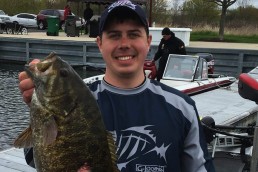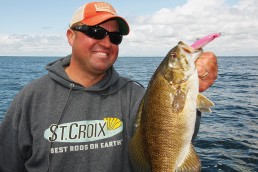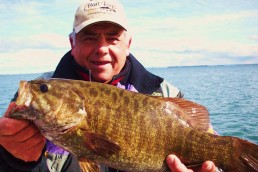Finesse Swimbaits Catch Monster Smallmouth Bass
SHARE THIS POST
Hands down, you need to add the finesse swimbait to your angling arsenal. I used to crawl a grub along the bottom, but once I started using finesse swimbaits a few years ago, I lost confidence in the grub. But with lost confidence, new confidence emerged in the finesse swimbait. Year in and out, the finesse swimbait has been my top producing bait for smallmouth bass throughout spring.
Finesse swimbaits have been influential in my tournament success, having led to multiple first-place finishes in Lake Michigan tournaments. At every smallmouth fishery I’ve been to, including Sturgeon Bay and Lake St. Clair, I’ve caught some of my biggest smallmouths on swimbaits.
When most people hear the word “swimbait,” their first thought is of a 1-pound, 6- to 8-inch oversized version of a trout. But I’m talking about a finesse swimbait, which ranges from 2.8 to 4 inches rigged on a round jig head. It may be on the smaller side, but it has proven itself to be a bait that big smallmouths destroy.
I started fishing finesse swimbaits by using one of the originators of the finesse swimbait, the 4-inch Keitech Swing Impact rigged on a 1/4-ounce jig head. I remember when I first fished it in an early-spring tournament on Lake Michigan. The pre-spawn smallmouth bass were jumping in the boat. Me and my partner thought we found the Holy Grail, we came to the weigh-in with 18 1/2 pounds!
Over the past few years using this bait, I have fine-tuned this technique and it has become a game changer and has quickly become my number 1 go-to bait early in the season.
Selecting the right swimbait
Since the finesse swimbait craze has taken over, there have been many tackle companies producing finesse swimbaits, making your selection difficult. When looking through all of the brands, be sure to examine baits thoroughly. Look for baits with very soft plastics and thin tails, which will get the tails kicking in a side-to-side motion while rotating in a circle. This is the action smallmouths will key in on.
I use different sizes based on water clarity. When water is ultra-clear and cold, I’ve found that the smaller 2.8-inch excels. The subtleness will provoke pressured fish to bite. In warm or stained water, I prefer larger baits at 3.8 to 4 inches. Larger baits displace more water putting off more vibration. This makes it easier for smallmouth to find in low-visibility conditions.
To help eliminate the rigorous search for the best finesse swimbait, I recommend the Jackall Rhythm Wave, which comes in both 2.8 and 3.8 inches. It’s made from very soft yet durable plastic that will catch multiple fish without getting torn apart. It also has an oval-shaped body that shimmies on the fall and during the retrieve, resulting in an incredible action that fish home in on.
The Keitech Fat Swing Impact is another excellent swimbait. It has squid scent and it is salt impregnated. The Keitech also comes in a plethora of sizes like a 3.3-inch bait, which can combine both properties of the 2.8- and 3.8-inch sizes. The downfall of these baits is that they do not hold up as well as the Rhythm Wave––and these little swimbaits can be expensive. Both of these are the two top swimbait manufacturers to go with. Jackall and Keitech have the best actions a great variety of fish-catching colors.
Color selection of finesse swimbaits
Color selection is critical when it comes to fishing finesse swimbaits. In most smallmouth lakes in the Midwest, smallmouths are feeding on shad, perch and gobies. Early in the year, when pre-spawn smallmouth bass are feeding on shad, it is hard to beat colors like sexy shad, blue top with a white belly, or straight white. When they are feeding on perch, I use the Jackall Rhythm Wave in Golden or Prism Shad. As the water warms up and gobies start to move in, I like colors in a green pumpkin top.
Are you enjoying this post?
You can be among the first to get the latest info on where to go, what to use and how to use it!
Jig head selection
What can you do to modify your finesse swimbaits?
I’ve found many circumstances where jig heads make all the difference in catching fish. On tournament day, I prefer starting out with an Owner ball-head jig with a 2/0 hook. I believe that Owner makes a good sharp hook. Additionally, the 2/0 light-wire hook is good because it will result in better hook-ups in shallow and deeper water. This ball head jig works best when matched with a 3.8- or 4- inch swimbait. I use 1/16-ounce head in shallow water and 1/8-ounce head in deeper water.
When the bite becomes tough and fish are in a negative mood, I switch to a Keitech tungsten ball-head jig with a short-shank hook, which gives the bait more action because there is more room for the tail to move. The short-shank hook also excels when fishing in the shallows. This ball head works best with the smaller 2.8- inch baits. I always stick to 1/16-ounce heads for the small swimbaits.
Lastly, I implement a 1/16-ounce Scrounger-head jig. The Scrounger gives the bait a side-to-side wobble. This works great when the water is dirty, the this jig moves a lot of water. The Scrounger also excels in heavy rock cover because it comes through the water in the same fashion as a square bill crankbait, deflecting off the bottom, resulting in fewer snags.
Regardless of jig head type, be sure to fish the lightest one possible, as lighter jig heads give bait a good kicking motion and will snag less. These baits can also be Texas rigged when fishing vegetation, but in most circumstances I use a ball-head jig. Be sure you carry a bottle of superglue and glue the nose of the bait to the jig head.
Retrieve and locations
Finesse swimbaits are one of the simplest baits to use in fishing. All you need do is throw it out and reel it slowly along the bottom. Finding the right cadence is key. In water temperatures ranging from 45 to 55 degrees, use a very slow retrieve and make sure your bait is in contact with the bottom to get sluggish fish to bite.
In water temperatures above 55 degrees, you can get away with using a medium-fast retrieve. This bait excels when you’re searching for fish that are getting ready to bed. I start my search looking for drop-offs containing gravel or small chunks of rock. Crawling finesse swimbaits along the contour lines will help you find pre-spawn bass. As the water warms up, I fish sandy flats where smallmouths will be up shallow, getting ready to spawn.
Remember, patience is key. Make sure your bait is in contact with the bottom and that you creep it along the bottom. Pre-spawn smallmouth bass react better to a slow and steady retrieve, when the water is warmer and bass are getting ready to take beds speed up your cadence.
Rigging up properly for the finesse swimbait
Since you will be casting extremely light baits long distances, you will need a longer rod with a soft tip.
I prefer a 7-foot 6-inch rod at medium power. This will allow your rod to load up correctly to cast this light bait farther. A light tip is necessary to whip light baits and work them around snaggy cover. I use a Shimano 2500-size reel spooled with 10-pound-test braided PowerPro. I connect the braid to a fluorocarbon leader, which gives me longer casts and maximizes sensitivity. When conjoining the leader, I recommend the Alberto knot. It is is tied by wrapping the smaller-diameter braid around the fluorocarbon, and passes through guides with ease. The Alberto knot is also a self-cinching knot that becomes stronger from more use.
I’ve found that the G. Loomis NRX 902 7-foot 6-inch, medium-power rod is my go-to rod for fishing a finesse swimbait.
The superior sensitivity of the NRX will help you decipher bottom content from even the lightest of bites––it’s as if a lightning bolt shot up your rod. I pair this rod with a Shimano Stradic CI4+ 2500 reel. Having a reel with quality gears will give you a smooth and steady retrieve, which is paramount to success.
Using finesse swimbaits and the presentation outlined above will help you catch more smallmouth bass. It works magic in all bodies of water throughout the Midwest. This bait will prove extremely beneficial for pre-spawn smallmouth bass, killer during spawning time, and it works great throughout the season. This technique is well worth mastering.
If you enjoyed this article on swimbaits by Bobby Bergren, check out this article on Fall Kng Salmon fishing!
MWO
SHARE THIS POST
Did you enjoy this post?
You can be among the first to get the latest info on where to go, what to use and how to use it!
Bobby Bergren
“Bobby B” Bergren is a smallmouth bass fishing fanatic who’s passion is fishing the Great Lakes. He has multiple first-place tournament wins on Lake Michigan. Additionally, he is a die-hard ice fishing enthusiast who targets bluegills, and dabbles in hunting and knife collecting. Bergren also engages in content creation and digital marketing for MidWest Outdoors.



